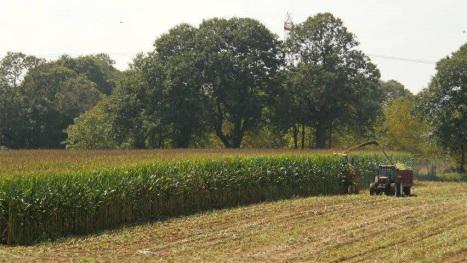The summer is going by quickly, and before we know it, this year’s corn crop will be ready to harvest for silage. Planning ahead can help to make sure that everything is ready for the silage harvest and makes certain that the best job possible is being done to reduce shrink and ensure that the stored crop will be a great source of feed.
Preparing the Storage Site
- Is there a clean, open area that will allow for easy filling and packing of the silage?
- Is the bunker sized correctly to make sure that enough silage can be removed from the face daily to prevent spoilage?
- Were there troubles with mud or water runoff from the bunker or silage bag area last year?
This is a good time to make changes to the silage pad or to do other dirt work to the surrounding area. Keep in mind that once that bunker starts filling up, making changes will be difficult if not impossible. Also, consider whether there are places along walls or on the floor that need to be repaired or sealed before the new crop is harvested. It is common to focus on covering the top of the bunker to keep out air but air can seep in through cracks and holes in the walls or along the sides of the bunkers.
Repairing any holes will prevent mold from developing in odd areas through your bunker. Make sure that the inoculant being used is stored properly and that there is a clear understanding of how to mix and apply. If you’re not sure, ask! Improper storage or mixing can negate any benefit of the inoculant.

Equipment
Oxygen is the enemy when harvesting silage. Consider what equipment is available to ensure that the silage will be able to be packed correctly and in a timely manner. Proper packing is necessary to remove oxygen and help start the fermentation process. Make sure tractors, choppers, and trucks are in working condition and ready to go. You don’t want equipment breaking down when you’ve still got more to do. Since covering the bunker is essential, make sure that there are proper materials on hand for covering the silage and holding the cover in place. If the bunk is left open to air there will be significant amounts of spoilage which should not be fed out.
Once everything is ready for the silage crop, continue to monitor the moisture of the corn crop closely to make certain the silage is harvested at the correct moisture level. Taking steps to prepare for silage harvest will help to ensure this year’s crop is stored properly and will be a great source of feed over the next year.
Quality Silage
Good quality forages are the basis for a successful nutrition program on any dairy. Unfortunately, when forage is low quality and grown on farm it can’t be returned or exchanged. No one wants to feed out poor quality forage and cows sure don’t want to eat it either. Remember to address the basics of forage management first. Inoculants cannot overcome poor forage management.
Be prepared, repair bunkers and equipment early, check moistures before harvesting, and reach out for help! A Famo Feeds representative is only a phone call away. Ten minutes on the phone or a farm visit are well worth it to avoid the aggravation of bad feed.

